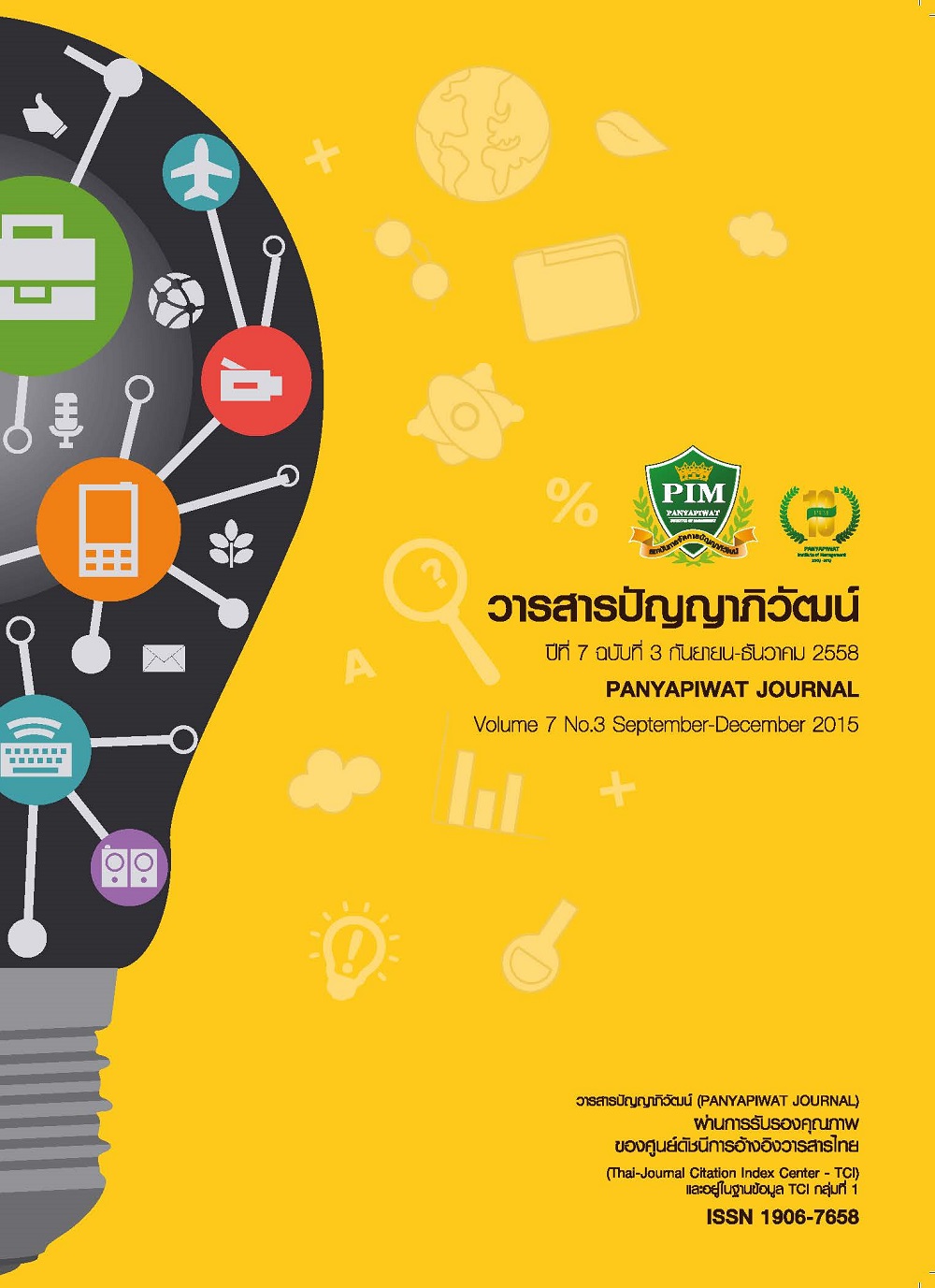การดำเนินงานสร้างเสริมสุขภาวะองค์กร กรณีศึกษา: องค์กรสร้างสุข
Main Article Content
บทคัดย่อ
การศึกษาครั้งนี้ มีวัตถุประสงค์เพื่อศึกษาความสุขในการทำงาน และเพื่อศึกษาวิธีการ ขั้นตอนการดำเนินงานสร้างความสุขในการทำงานขององค์กรที่เข้าร่วมโครงการถอดรหัส 102 องค์กรหลากสุข โดยเป็นการวิจัยเชิงสำรวจ (Survey Research) ด้วยวิธีการสัมภาษณ์ (Interview) ผู้บริหาร ผู้ปฏิบัติงานในฝ่ายทรัพยากรมนุษย์ และพนักงานในระดับปฏิบัติการ โดยทำการศึกษาจากองค์กรที่เข้าร่วมโครงการถอดรหัส 102 องค์กรหลากสุข จำนวน 2 องค์กร ได้แก่ บริษัท ชัยบูรณ์ บราเดอร์ส จำกัด และ บริษัท สายการบินนกแอร์ จำกัด (มหาชน)
ผลการวิจัย สรุปได้ดังนี้ 1) ผลการศึกษาความสุขในการทำงานของบุคลากรองค์กรสร้างสุข พบว่า ความสุขในการทำงานเกิดจาก ลักษณะของงาน สัมพันธภาพในการทำงาน บรรยากาศและสภาพแวดล้อมในการทำงาน การได้รับการสนับสนุนสวัสดิการขององค์กร และการได้รับการยอมรับทางสังคม 2) ผลการศึกษา การดำเนินงานสร้างเสริมสุขภาวะองค์กรขององค์กรสร้างสุข พบว่า การดำเนินงานสร้างเสริมสุขภาวะองค์กร ประกอบไปด้วย การได้รับการสนับสนุนจากผู้บริหารระดับสูงขององค์กร การมีวิสัยทัศน์ กลยุทธ์ และเป้าหมายที่เอื้อต่อการเป็นองค์กรสร้างสุข มีคณะกรรมการ หน่วยงาน หรือบุคลากรที่ดูแลงานด้านการสร้างเสริมสุขภาวะองค์กร การใช้แบบสอบถามเพื่อสอบถามความคิดเห็นและความต้องการของบุคลากร เพื่อนำมาจัดกิจกรรมการสร้างสุขในองค์กรต่อไป
The Objective of this study was to study the work happiness and the operation in order to build Happy Workplace of 102 Happy Workplaces. This was a Survey Research studying at two organizations of 102 Happy Workplaces, Chaiyaboon Brothers Company limited and Nok Airlines Public Company Limited, were researched as the case studies and gathering the data by interview the participants including the executives, human resource operatives, and employees of both organizations.
The results revealed that the work happiness in the employee of Happy Workplace was caused by job characteristic, working relationship, work environment and atmosphere, perceived welfare organizational support and social recognition. The Results revealed that the operation of building Happy Workplace included as followed; the support from the executive of the organization; establishing vision, strategy and goal that contribute to Happy Workplace; accreditation of department, committee or an operative who is responsible for the operation of building happy workplace; and using the questionnaire for gather the opinions and demands of staff for arrangement of the activities creating happy workplace in the organization.
Article Details
“ข้าพเจ้าและผู้เขียนร่วม (ถ้ามี) ขอรับรองว่า บทความที่เสนอมานี้ยังไม่เคยได้รับการตีพิมพ์และไม่ได้อยู่ระหว่างกระบวนการพิจารณาลงตีพิมพ์ในวารสารหรือแหล่งเผยแพร่อื่นใด ข้าพเจ้าและผู้เขียนร่วมยอมรับหลักเกณฑ์การพิจารณาต้นฉบับ ทั้งยินยอมให้กองบรรณาธิการมีสิทธิ์พิจารณาและตรวจแก้ต้นฉบับได้ตามที่เห็นสมควร พร้อมนี้ขอมอบลิขสิทธิ์บทความที่ได้รับการตีพิมพ์ให้แก่สถาบันการจัดการปัญญาภิวัฒน์หากมีการฟ้องร้องเรื่องการละเมิดลิขสิทธิ์เกี่ยวกับภาพ กราฟ ข้อความส่วนใดส่วนหนึ่งและ/หรือข้อคิดเห็นที่ปรากฏในบทความข้าพเจ้าและผู้เขียนร่วมยินยอมรับผิดชอบแต่เพียงฝ่ายเดียว”
เอกสารอ้างอิง
ขวัญเมือง แก้วดําเกิง, ดวงเนตร ธรรมกุล, อัจศรา ประเสริฐสิน และจําเนียร ชุณหโสภาค. (2556). Happy Workplace Index ดัชนีสุขภาวะองค์กร. กรุงเทพฯ: ศูนย์องค์กรสุขภาวะ สํานักงานกองทุนสนับสนุนการสร้างเสริมสุขภาพ (สสส.).
ชัยนันท์ แสงสุระธรรม. (2552), องค์กรแห่งความสุข. Productivity Corner, 9(111), 7-9.
ชาญวิทย์ วสันต์ธนารัตน์. (2553). CSR ในองค์กร ก้าวหน้าอย่างมีสุขด้วย Happy Workplace. กรุงเทพฯ: สํานักงานกองทุนสนับสนุนการสร้างเสริมสุขภาพ.
ดวงเนตร ธรรมกุล. (2555). การสร้างสุขภาวะในองค์กร (Developing Healthy Organization), วารสารวิจัยทางวิทยาศาสตร์สุขภาพ, 6(1), 4-6.
แผนงานสุขภาวะองค์กรภาคเอกชน. (2552). ร้อยความคิดสร้างสุของค์กร. กรุงเทพฯ : สํานักงานกองทุนสนับสนุนการสร้างเสริมสุขภาพ.
วุฒิพงศ์ ถายะพงค์. (2549), อยู่อย่างไรให้เป็นสุข. กรุงเทพฯ: มติชน.
ศิรินันท์ กิตติสุขสถิต และคณะ. (2556). คุณภาพชีวิต การทํางานและความสุข. นครปฐม: สถาบันวิจัยประชากรและสังคม มหาวิทยาลัยมหิดล.
สํานักงานคณะกรรมการพัฒนาเศรษฐกิจและสังคมแห่งชาติ. (2555). แผนพัฒนาเศรษฐกิจและสังคมแห่งชาติ ฉบับที่ 11 (พ.ศ. 2555-2559). สืบค้นเมื่อ 16 พฤศจิกายน 2556, จาก http://www.nesdb.go.th/Portals/0/news/plan/p11/plan11.pdf
อุทัยทิพย์ เจียวิวรรธน์กุล และคณะ. (2556). Happy 8 menu กล่องแห่งความสุข 8 ประการ. กรุงเทพฯ : ศูนย์องค์กรสุขภาวะ
สํานักงานกองทุนสนับสนุนการสร้างเสริมสุขภาพ.
Christiansen, J. A. (2000). Building The Innovative Organization: Management Systems that Encourage Innovation. Hampshire: Macmillan Press.
Higgins, J. M. (1995). Innovate or Evaporate: Test & Improve Your Organization's IQ – Its Innovation
Quotient. New York: New Management Publishing Company.
Page, K. M. & Vella-Brodrick, D. A. (2009). The 'What', 'Why' and 'How' of Employee Well-Being: A New Model. Social Indicators Research, 90(3), 441-458.
Translated Thai References
Corporate health plans. (2009). Hundreds of ideas...creating a happy organization. Bangkok: ThaiHealth Promotion Foundation. [in Thai]
Jiawiwatkul, U. et al. (2013). Happy 8 menu. Bangkok: Happy Workplace Center ThaiHealth Promotion Foundation. [in Thai]
Kaewdumkaeng, K., Thammakul, D., Prasertsin, A. & Chunhasopak, J. (2013). Happy Workplace Index. Bangkok: Happy Workplace Center ThaiHealth Promotion Foundation. [in Thai]
Kittisuksatit, S. et al. (2013). Quality of Life, Work and Happiness. Nakhon Pathom: Institute for Population and Social Research, Mahidol University. [in Thai]
Office of the National Economic and Social Development Board. (2012). The Eleventh National Economic and Social Development Plan (2012-2016). Retrieved November 16, 2013, from http://www.nesdb.go.th/Portals/0/news/plan/p11/plan 11.pdf [in Thai]
Sangsutham, C. (2009). Organization of happiness. Productivity Corner, 9(111), 7-9. [in Thai]
Thammakul, D. (2012). Developing Healthy Organization. Journal of health science research, 6(1),4-6. [in Thai]
Thayapong, W. (2006). How to stay happy. Bangkok: Matichon. [in Thai] Wasanthanarat, C. (2010). CSR in Organization Happy with progress by Happy Workplace. Bangkok: ThaiHealth Promotion Foundation. [in Thai]


